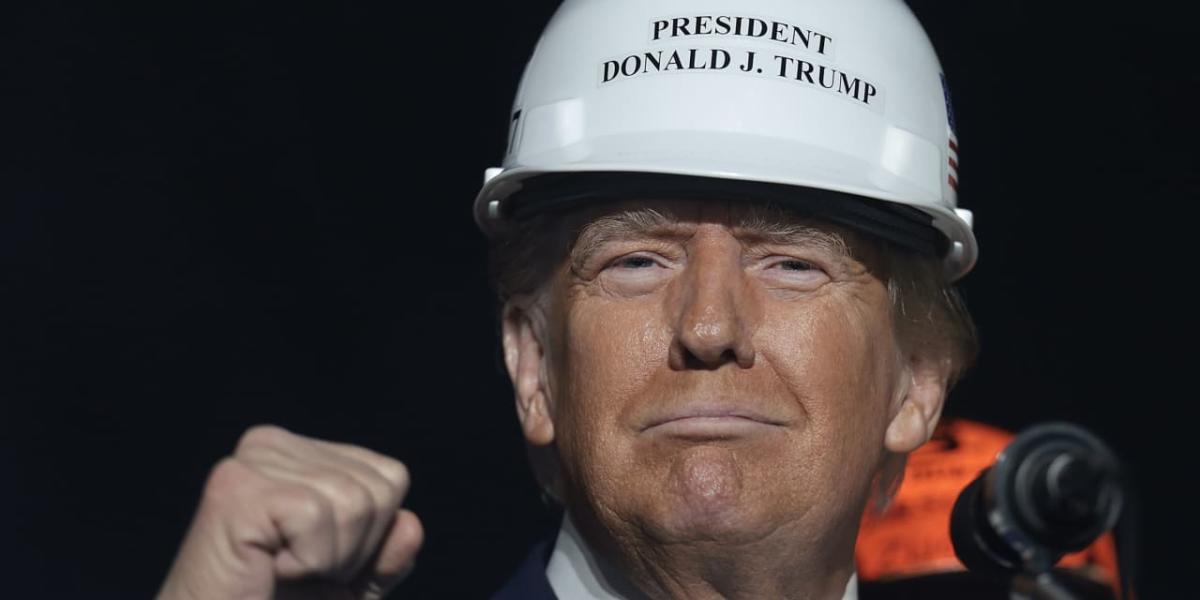6 ways a second Trump presidency will affect home buyers and sellers


Voters unhappy over soaring prices, including runaway housing costs, helped put Donald Trump back in the White House. But what will a second Trump presidency mean for the real-estate industry, and home buyers and sellers?
It means higher mortgage rates in the immediate term, but further down the line, another Trump administration could also mean less regulation and more tax incentives across the board, experts told MarketWatch.
“There’s likely to be two sides of the coin,” Mike Fratantoni, chief economist at the Mortgage Bankers Association, a trade group, told MarketWatch.
Though Trump’s policies could lead to more tax perks and lighter regulation that could help home buyers and builders, Fratantoni explained, his policies could also trigger a bigger federal deficit, which could push up mortgage rates.
Expect mortgage rates to remain elevated in the aftermath of the election. The 30-year mortgage rate averaged 7.13% as of Nov. 6, according to Mortgage News Daily.
“Overnight, we’ve seen the 10-year Treasury rate up about 20 basis points,” Fratantoni said, “so you could reasonably expect that it is going to translate pretty closely to a similar increase in mortgage rates.”
Mortgage rates tend to rise and fall in tandem with the 10-year Treasury note BX:TMUBMUSD10Y, rather than following the Federal Reserve’s benchmark interest rate. The 10-year Treasury note has risen sharply over the past few weeks, in anticipation of a Trump victory, pulling up the 30-year mortgage rate along with it. Treasury yields typically go up when investors expect inflation to increase.
With the Trump administration, expect a higher level of growth in the U.S. economy, higher inflation, and hence, a higher interest rate, Fratantoni said.
The volatility is expected. When Trump was last elected in 2016, mortgage rates also went up, Danielle Hale, chief economist at Realtor.com, told MarketWatch.
Realtor.com is operated by News Corp subsidiary Move Inc., and MarketWatch is a unit of Dow Jones, which is also a subsidiary of News Corp.
Between Nov. 5, 2020 and Nov. 12, 2020, the 30-year mortgage rate increased from 2.78% to 2.84%, before dropping again the following week to 2.72%, based on Freddie Mac data.
But the longer-term outlook for home buyers is bleak, Lisa Sturtevant, chief economist at Bright MLS, said in a statement.
In the near term, “we should expect more volatility in the housing market,” Sturtevant said. But over the longer term, expect homeownership to be “harder to attain for first-time and moderate-income home buyers,” she added, “as his policies favor high-income individuals and existing homeowners.”
Several of Trump’s plans — from imposing tariffs on imported goods to cracking down on immigration — could lead to higher mortgage rates through the end of this year, the experts noted. But one particular pain point is the outstanding issue of the federal deficit, which has an impact on mortgage rates.
See also: 7% mortgage rates are a warning about who will win the election, economist says
Because mortgage rates follow the direction of the yield on the 10-year Treasury, higher federal borrowing costs for the government’s debt in the future could in turn lead to higher mortgage rates for buyers, according to the Bipartisan Policy Center.
To that end, “bond yields are rising because investors expect Trump’s proposed fiscal policies to widen the federal deficit and reverse progress on inflation,” Sturtevant said.
Therefore, expect Trump’s silence on the federal deficit to push up rates, Lawrence Yun, chief economist at the National Association of Realtors, told MarketWatch. “In the short term, mortgage rates will tick higher as the budget deficit outlook does not improve, even as the Fed is cutting its short-term interest rates.”
Unless Trump’s actions lead to inflationary pressures subsiding, the Fed will not make deeper interest-rate cuts, which will keep mortgage rates high, Yun explained.
Read more:
But when it comes to mortgage rates, the one thing that we know for sure is that Americans will not be seeing 2% mortgage rates in the foreseeable future, despite the president-elect’s promise on the campaign trail to bring mortgage rates down to that level, the economists said.
“You never say never, but the circumstances that would bring mortgage rates that low again are unhappy,” Fratantoni said. Presidents do not have the power to bring down mortgage rates.
“We had to live through a pandemic to get there, so it would take a major economic crash or another downside … to get the benefit of very low mortgage rates,” he added.
Expect higher prices on homes, as Trump’s proposed tariffs on imported goods have the potential to increase the cost of building a house.
Read more:
When he was last president, Trump imposed tariffs on Canadian lumber shipped into the U.S., which have persisted under the Biden administration, according to the National Association of Home Builders. That has driven up the average cost of a newly built home by about $14,000, according to an 2022 estimate by the National Association of Home Builders.
Other factors have also driven up the cost of building a home, including: the lack of availability and affordability of developable land, the cost of labor, the cost of building materials aside from lumber, and government regulation involved in the process of building, Jim Tobin, chief executive of the National Association of Home Builders, told MarketWatch.
In particular, the industry has faced an acute labor crunch: “We face a 300,000 to 400,000 worker shortage in the construction industry,” Tobin said. Even though the industry has tried to attract more young workers, he said, home builders still rely on recent immigrants to fill many roles. Immigrant workers account for 25% of the construction workforce, according to an NAHB report published in the spring.
Trump’s proposed plans for mass deportations of immigrants could have a “chilling effect on the construction industry,” Sturtevant said, as it could shrink the number of construction workers and stall housing construction.
Expect more tax incentives that could boost home building under a Trump presidency.
Though increased inventory could, in theory, lead to lower home prices, those declines could be offset by increases in home-buying costs created by Trump’s tariffs and higher mortgage rates, experts told MarketWatch.
David Dworkin, president and chief executive of the National Housing Conference, a centrist nonprofit advocacy group, said he was optimistic that a second Trump administration could result in housing tax credits that could help home buyers and builders, which could have a big impact on housing supply.
A lack of homes on the market caused in part by a new-home inventory crunch has helped drive home prices to record highs this year.
Dworkin expects a reimagined form of so-called “opportunity zones” to emerge. Opportunity zones were created by Congress through Trump’s Tax Cuts and Jobs Act of 2017, and allow companies or individuals to invest in designated low-income areas in exchange for certain tax benefits, such as deferring capital-gains taxes. Dworkin says he believes opportunity zones have encouraged the development of affordable housing.
“There’s an opening for a revision of some of the opportunity zones, and how they approach affordable homeownership,” Dworkin said.
During his last administration, Trump preserved the low-income housing tax credit in the TCJA. The LIHTC program, created in 1986, contributes to the development of affordable housing in the U.S.
Expect a pullback in regulation under a Trump presidency, which could stimulate more activity in the housing market, experts said.
With Trump in the White House, “expect a lighter-touch regulatory environment,” Fratantoni said, “both in the lending and the building space. That’s generally going to be positive for the housing and lending markets.”
Builders are also looking forward to Trump’s second term. “President Trump made housing policy and more housing supply a centerpiece of his economic platform,” NAHB’s Tobin said.
Among builders he has spoken with, “the sentiment is optimistic,” Tobin added. “In their mind, the last four years with President Biden were accompanied by increased regulatory pressures … and they see lower regulations under President Trump which should spur homebuilding.”
Dworkin agreed, adding that the regulatory agenda of the Biden administration was very aggressive. “As a regulator, you can be a lapdog, a guard dog, or an attack dog… and we need a guard dog,” he said. “Voters have been clear that they want regulation that does not treat corporations like they’re the enemy.”
Read more:
Expect more talk of bringing Fannie Mae and Freddie Mac, two government-sponsored enterprises that back the bulk of residential mortgages in the U.S., back into the public markets.
Trump allies had been working on plans to privatize the two entities, the Wall Street Journal reported in September. The two government-sponsored enterprises have been under government control since 2008, in the wake of the financial crisis. They purchase and securitize mortgages, both residential and commercial, and sell them on the secondary market.
Trump tried to privatize these two housing-finance entities in his first term, but the pandemic hit the brakes on that proposal.
“Any reasonable person will say that Fannie and Freddie were never intended to be in conservatorship for 16 years,” Dworkin said.
But pushing them to the public markets once again needs to be handled carefully, he added. “It’s no one’s interest that the housing markets are disrupted, so how they’re released from conservatorship is going to be where the real effort needs to be focused.”
“The industry’s biggest concern is any threat to the stability and liquidity in the secondary market,” Fratantoni said. Liquidity, meaning easy access to funds, is “paramount,” he added so that lenders are able to offer loans to home buyers.
But don’t expect the 30-year mortgage to go away if Fannie and Freddie go public once again. “The 30-year mortgage has been a hallmark of the U.S. housing market since the Great Depression,” Fratantoni said. “The product is very much a favorite of U.S. home buyers and homeowners, so it will be retained. It is more of a question of the price stability, and the liquidity in the secondary market.”
For the average home buyer, nothing changes immediately as Trump replaces Biden in the White House, Daryl Fairweather, chief economist at Redfin RDFN, told MarketWatch.
“Homes will still be in short supply. If the economy is growing, rents and home prices will grow too. The cost of borrowing isn’t likely to come down much,” she said.
“With Republicans in control, national housing affordability is not a top concern,” she added, “so expect the status quo to continue.”
NAHB’s Tobin was a little less glum about the prospects for home builders — and buyers who can afford homes at current prices and rates.
“I expect that a Trump economy will do better. People will start feeling better about the economy,” he said, and be willing to financially stretch themselves to buy homes despite elevated mortgage rates.
What personal-finance issues would you like to see covered in MarketWatch? We would like to hear from readers about their financial decisions and money-related questions. You can fill out or write to us at . A reporter may be in touch to learn more. MarketWatch will not attribute your answers to you by name without your permission.








